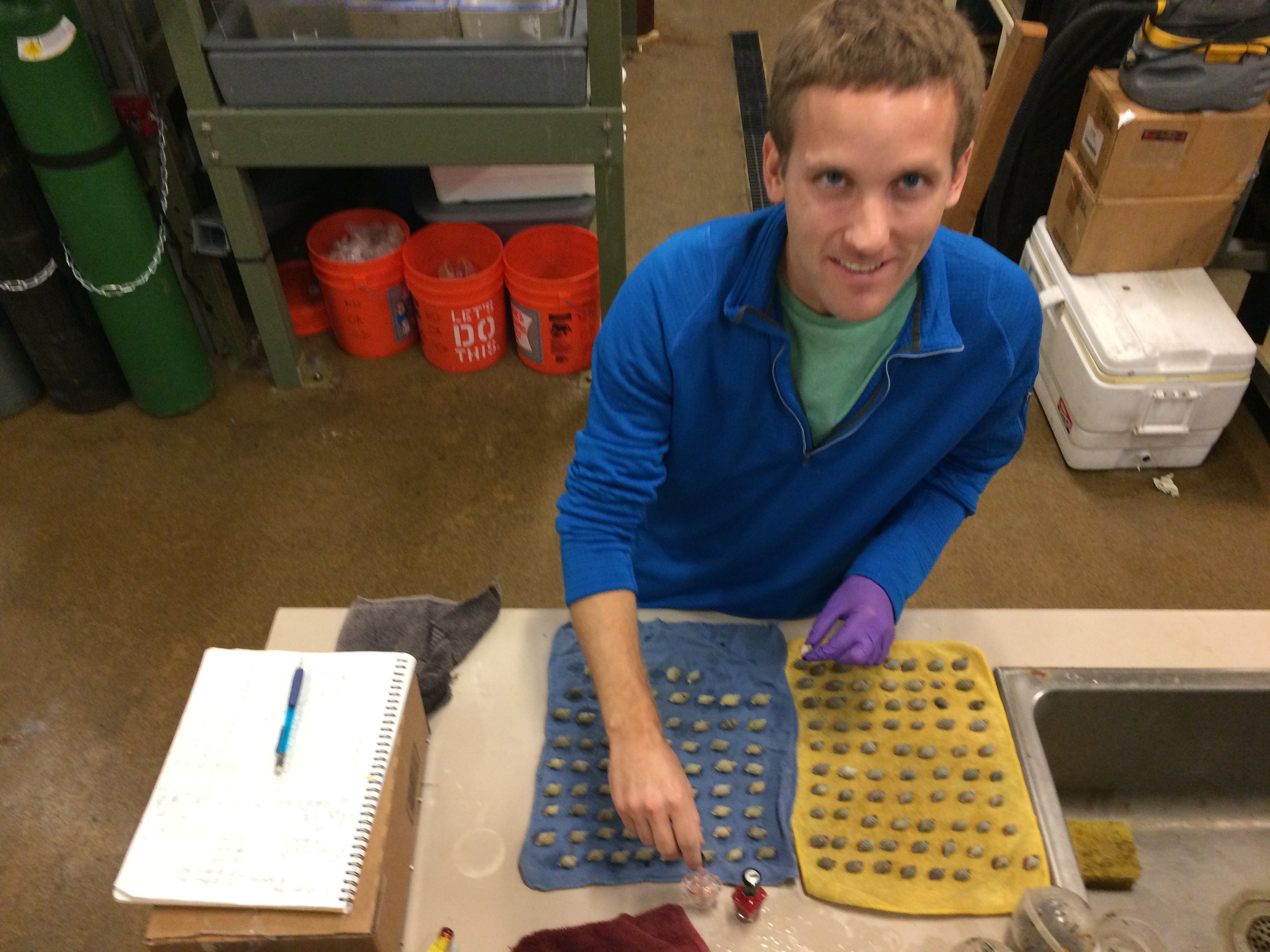Methods
Summary
I will collect crabs and snails near Bodega Marine Lab, where I have collected them in the past (I have a CA Scientific Collecting Permit). I will keep crabs and snails in the seawater system at the Monterey Bay Aquarium Research Institute for the duration of the experiment. Since the goal of the project is to measure the shell defenses of the snail Nucella ostrina, it is important to accurately measure the shells before and after the experiment. I have published several studies on snail shells in the past (example 1, example 2), so I have the expertise necessary to perform this type of experiment.
I will weigh the snails in air and in water at the start of the experiment, because the ratio of these weights is an accurate way to see how heavy a shell is without killing and dissecting the animal. Obviously it is important to not harm the animals even before the experiment starts! I will also paint the edge of the snail shell with nail polish--when they grow, they extend their shell from the opening, so I will be able to see at the end of the experiment how much shell they added. Below you can see me painting nail polish on snail shells for a previous experiment!
I will keep half of the snails in tanks that have crabs in them, and half in tanks with no crabs. The snails can sense (smell) the chemicals released by the crabs in the water, so they know that the crabs are there and will attempt to produce a thicker shell as a result. Half of the crab tanks and half the non-crab tanks will be acidified, meaning that the pH will be lower and it will be more difficult for the snails to produce shells. We don't know how the snails will respond to this--they may be unaffected, they may produce thicker shells but grow slower, or they may not be able to make thicker shells at all (which would be a bad outcome for the snail).
At the end of the 2-month experiment I will weigh and measure the snails again to see how much they grew and how thick their newly produced shell is. I will also use a Dremel with a diamond-coated blade to cut off the area of new shell growth, so that I can grind up the new shell and send it off to an X-Ray Diffractometry lab at UC Santa Barbara. This will tell me if the snails changed the chemical makeup of their shell with ocean acidification. Some types of shell material are more difficult to produce but are stronger, and it is possible that snails could shift to an easier but weaker shell material with acidification. The best way to test for this is X-ray diffractometry, which will tell me the main compounds in the shells.
This type of project has not been done before and will be a big step towards understanding how (or if) snails can defend themselves from predators with ocean acidification.
Challenges
The biggest challenges are knowing how to accurately measure snail growth and knowing how to build an acidification setup that can keep the snails alive for a long-term experiment. I have done both of these before (see papers linked in methods) and have a great deal of experience with conducting long-term laboratory experiments with a wide range of animals, so I don't expect any issues.
Pre Analysis Plan
My hypothesis is that snails will not be able to produce a thicker shell in the presence of crabs under ocean acidification conditions because it is more difficult to make shell material.
The primary data coming from this experiment will be several growth and feeding metrics including: # of mussels eaten per snail, new shell weight, new shell density, new shell length, shell chemical composition (calcite v. aragonite). Because there are two sets of two factors (crab v. no crab, pH 8.0 v. pH 7.6), this is a factorial design that is ideal for analysis with a two-way ANOVA (analysis of variance) test. This will tell me if there are significant differences in shell characteristics between the different pH and crab treatments. They will likely be large variability in snail shell growth, but there will be 16 snails in each treatment, enough replication that I will be able to see the large patterns.
If there is a significant difference in any shell characteristics between crab and no crab treatments, that means that the snails have an inducible defense to this predator (because they produce a thicker shell when it was there). If there is no significant difference at the two pH levels, it means that the snails are still able to defend themselves from crabs at future ocean conditions (and vice versa).
Protocols
This project has not yet shared any protocols.
